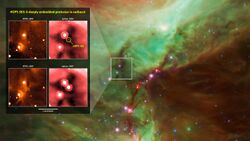Astronomy:HOPS 383
Coordinates: ![]() 5h 35m 29.81s, −4° 59′ 51.1″
5h 35m 29.81s, −4° 59′ 51.1″
| Observation data Equinox J2000.0]] (ICRS) | |
|---|---|
| Constellation | Orion |
| Right ascension | 5h 35m 29.81s |
| Declination | −4° 59′ 51.1″ |
| Characteristics | |
| Evolutionary stage | Class 0 protostar |
| Astrometry | |
| Distance | 1,400 ly (420 pc) |
| Other designations | |
HOPS 383 | |
| Database references | |
| SIMBAD | data |
HOPS 383 is a Class 0 protostar. It is the first class-0 protostar discovered to have had an outburst,[1] and as of 2020, the youngest protostar known to have had an outburst.[1] The outburst, discovered by the Herschel Orion Protostar Survey (HOPS) team, was first reported in February 2015 in The Astrophysical Journal Letters.[2]
Observations
Outburst
HOPS 383 had an outburst between 2004 and 2006 (a "dramatic mid-infrared brightening"); the increase in magnitude was detectable at the 24 μm (35 times increase) and 4.5 μm, and was also detectable at the submillimetre.[3]: 2 After 6 years, observations showed no signs of fading.[3]: 1
X-Ray
The Chandra X-Ray Observatory detected an X-ray flare from HOPS 383 in December of 2017.[4] This was the first detection of X-rays from a Class 0 protostar that will evolve into a sun-like star.[4] The flare lasted 3 hours and 20 minutes.[5] It significantly impacted the previously-thought timeline for when such events occur in the evolution of a protostar. Furthermore, it has improved astronomers' understanding of the Sun's earlier evolutionary stages.
References
- ↑ 1.0 1.1 "NASA satellites catch 'growth spurt' from newborn protostar". Science Daily. 24 March 2015. https://www.sciencedaily.com/releases/2015/03/150324183632.htm.
- ↑ McKinney, Donna (2015-02-25). "NRL Astrophysicist Explores Star Formation in Orion's Belt". United States Naval Research Laboratory. https://www.nrl.navy.mil/Media/News/Article/2539366/nrl-astrophysicist-explores-star-formation-in-orions-belt/.
- ↑ 3.0 3.1 Safron, Emily J.; Fischer, William J.; Megeath, S. Thomas; Furlan, Elise; Stutz, Amelia M.; Stanke, Thomas; Billot, Nicolas; Rebull, Luisa M. et al. (2015-02-10). "Hops 383: An Outbursting Class 0 Protostar in Orion". The Astrophysical Journal Letters 800 (1): L5. doi:10.1088/2041-8205/800/1/L5. ISSN 2041-8205. Bibcode: 2015ApJ...800L...5S. https://www.osti.gov/biblio/22364255.
- ↑ 4.0 4.1 "Chandra :: Photo Album :: HOPS 383 :: June 18, 2020". https://chandra.harvard.edu/photo/2020/hops383/.
- ↑ "Chandra Press Room :: X-rays From a Newborn Star Hint at Our Sun's Earliest Days :: 18 June 2020". https://chandra.harvard.edu/press/20_releases/press_061820.html.
 |

